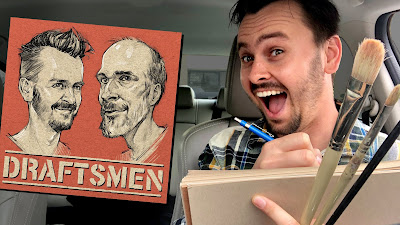It's a new year.
For me that means reviewing the goals of past years to see where I've fallen short.
And—WOW!—have I fallen short!
Year after year after year—going back almost TWENTY years!—I've had the SAME goals!
To learn anatomy; to complete several animated shorts; to socialize more; to get fit; blah, blah blah.
But I keep missing these goals, especially the drawing-related goals. So why does that keep happening?
After searching for the answer to that question, I came to an unfortunate answer: learning to draw is BORING!
That's right, I said it! I love drawing but
learning to do it well—with the necessary repetitions and the strain on my brain as I desperately try to determine why my drawings are wrong—is BORING!
Gesture drawing is boring.
Drawing drills are boring.
Studying anatomy is REALLY boring!
I'll have one or two weeks of solid practice and then fall off the wagon. WAY off the wagon. Then I'll get back on the wagon only to fall off again. Then I get distracted by something else and before I know it, another year has passed and I've gotten nowhere.
So
this time when I was reviewing my 2019 and thinking about what I wanted to accomplish in 2020, I admitted an uncomfortable truth: even though I love drawing, I hate practicing it.
That acknowledgement was HUGE! By saying the truth out loud, I allowed myself to feel and embrace the negative side of pursuing my passion. By embracing that negativity, it forced me to FINALLY find a way around it. And the solution I've come up with is so far working!
I determined that I need to focus on a few areas to improve my figure drawing: gesture, simplifying the torso and pelvis (the primary area of physical movement), figure proportions and drawing drills. The first good decision I made was to limit my focus to only those areas. It helps that I've finally had a breakthrough in understanding the 5 basic forms—cube, cylinder, cone, pyramid and sphere—and have developed the ability to break
everything down into those forms. Now, learning to draw the figure is my primary focus.
But studying and practicing those things is boring. In order to overcome the boredom, I realized that I needed to balance it with something FUN that also helps improve my skills. The activity I found to accomplish that is
copying.
Copying allows me to spend time with the work by artists whom I want to emulate. I love Moebius's work, so I copy it. I love Harvey Kurtzman and other MAD magazine artists, so I copy them. This is similar to rewarding oneself with a cookie after having eaten some kale. Well…it's actually BETTER than that because copying is healthy for one's drawing abilities while a cookie isn't but…you get my point.
I've only just started this new approach so I can't yet say if it's a success. I'll be documenting my progress here.
But I do know that at the least, drawing has become a lot less boring. 😁

























